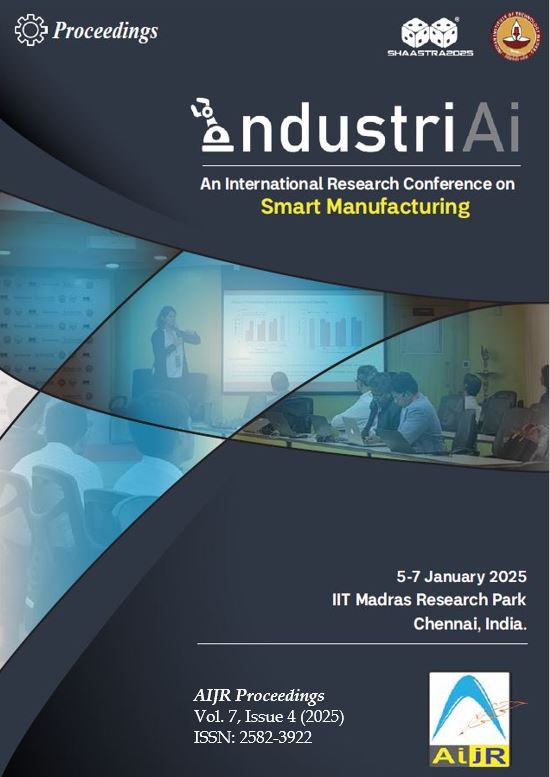Developing Bio-Inspired Adaptive Manufacturing Systems in Real Time
DOI:
https://doi.org/10.21467/proceedings.7.4.3Keywords:
Adaptive manufacturing, Bio-inspired systems, decentralized controlAbstract
The evolving manufacturing landscape, characterized by increasing demands for customization, flexibility, and efficiency, requires adaptive systems that can respond in an autonomous and dynamic way. Bio-inspired Adaptive Manufacturing Systems, or Bio-AMS, provide a novel answer by integrating principles from nature that include self-organization, resilience, and adaptability. This paper covers the development and application of Bio-AMS, in which biological inspiration from organisms and ecosystems was applied to create systems that would adapt to varying production demands, disturbances, and resource constraints. In this manner, Bio-AMS enhances both the efficiency and scalability of systems with decentralized control, adaptive feedback, and MAS architectures. Simulations show that Bio-AMS outperforms conventional systems in terms of minimizing downtime and maximizing productivity. Case studies demonstrate their capability for autonomous adaptation to disruption and therefore operational resilience. Future work focuses on refining the algorithms, integrating advanced technologies like AI and IoT, and taking the applications to various industries.
References
[1] Y. LeCun, Y. Bengio, and G. Hinton, "Deep Learning," Nature, vol. 521, pp. 436–444, 2015.
[2] S. Zhang and Y. Wang, "Evolutionary Strategies in Manufacturing," Journal of Manufacturing Systems, vol. 34, pp. 1034–1046, 2020.
[3] S. P. Borgatti, "Decentralized Manufacturing Systems," Journal of Organizational Behavior, vol. 29, pp. 167–181, 2017.
[4] J. Lin, L. D. Xu, and W. Wang, "IoT and HR Analytics Integration," IEEE Systems Journal, vol. 45, pp. 23–34, 2017.
[5] K. Schwab, “The Fourth Industrial Revolution”, World Economic Forum, vol. 12, pp. 9–16, 2016.
[6] D. Ulrich, “Human Resource Champions”, Harvard Business Press, vol. 22, pp. 14–23, 1998.
[7] J. Brownlee, "Swarm Intelligence in Optimization," Machine Learning Mastery, vol. 9, pp. 132–149, 2021.
[8] M. Dorigo and T. Stützle, “Ant Colony Optimization”, MIT Press, vol. 1, pp. 243–256, 2000.
[9] P. Zhang and M. Lee, "Smart Factories and Adaptive Control Systems," Journal of Intelligent Manufacturing, vol. 31, no. 2, pp. 513–528, 2021.
[10] S. A. Bousaba and P. Fong, "IoT-Driven Manufacturing Optimization," International Journal of Production Research, vol. 10, pp. 187–198, 2020.
[11] Y. Li and Z. Yang, "Applications of Multi-Agent Systems in Manufacturing," Robotics and Computer-Integrated Manufacturing, vol. 16, pp. 303–319, 2018.
[12] A. Kumar and T. Bose, "Real-Time Decision Optimization in Manufacturing," IEEE Transactions on Industrial Informatics, vol. 13, no. 5, pp. 2456–2463, 2020.
[13] S. Russell and P. Norvig, “Artificial Intelligence: A Modern Approach”, Pearson, vol. 11, pp. 85– 110, 2016.
[14] R. Gupta, "Predictive Analytics in Industry 4.0," Industrial Management & Data Systems, vol. 8, pp. 145–160, 2021.
[15] H. Mintzberg, “The Structuring of Organizations”, Prentice-Hall, vol. 18, pp. 423–450, 1991.
[16] M. Thomas and C. J. Anumba, "Neural Networks in Real-Time Manufacturing," Advanced Engineering Informatics, vol. 25, pp. 205–219, 2019.
[17] L. Chen and K. Tan, "Energy Efficiency in Cyber-Physical Production Systems," Computers & Industrial Engineering, vol. 149, pp. 106805, 2020.
[18] E. Stewart and F. Morris, "Dynamic Human-Machine Collaboration in Industry 5.0," Procedia Manufacturing, vol. 52, pp. 388–395, 2021.
Downloads
Published
Issue
Section
License
Copyright (c) 2025 Debaleena Ghatak (Author)

This work is licensed under a Creative Commons Attribution-NonCommercial 4.0 International License.

